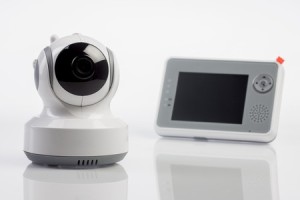 If you’re looking for tips on choosing a baby monitor, you’ve landed on the right page.
If you’re looking for tips on choosing a baby monitor, you’ve landed on the right page.
If you are a first-time parent-to-be, a baby monitor will no doubt be on your list of things to buy before the new family member arrives. With a number of different types to choose from, you probably have some questions regarding which is the best baby monitor to buy.
While any good baby monitor will keep your little one safer, it can be difficult to make a decision about which kind to buy. Models on offer range from the baby sound monitor to the baby video monitor and the baby motion monitor. Each has variations, and some come with additional useful features.
Before we look at how to choose a baby monitor, we will look at their benefits and how they work. We will also discuss the differences between the various types of monitor. Knowing this will make it easier for you to make your selection.
Why Buy a Baby Monitor?
If you’re a new parent, you may be especially anxious and feel the need to keep going into the nursery to check on your baby. A quality baby monitor will enable you to keep an eye on your baby at all times, from any room in the house. The peace of mind this gives is well worth the modest cost of buying a baby monitor. And, in the worst-case-scenario, it could save your little one’s life.
How Do Baby Monitors Work?
For those unfamiliar with the way they work, baby monitors are small devices containing a transmitter and a receiver. The transmitter stays in the baby’s nursery or the room you want to monitor. For convenience, a wired receiver should be placed in a part of the house where you spend a lot of time. This will provide you with audio and/or video coverage of the nursery, without you having to leave the room. A wireless model is the most portable option. It won’t need to be plugged into a power source, so you can easily take it to another spot in the house.
The Wired Baby Monitor Vs. the Wireless Baby Monitor
Most modern baby monitors, wired or wireless, operate by way of digital technology. This produces a  clearer signal and a greater range of operation than most analog models. The primary difference between a wired baby monitor and a wireless baby monitor is their portability.
clearer signal and a greater range of operation than most analog models. The primary difference between a wired baby monitor and a wireless baby monitor is their portability.
A wired baby monitor must be fixed into place. This makes it more restrictive than a wireless baby monitor. With the former, you will only be able to monitor your child from the room in which the receiver is set up. Another downside of a wired model is that its range is limited by the length of the wires that are attached to the receiver.
A wireless baby monitor offers far more flexibility. You can carry it around, or even clip it onto your clothing. Some monitors are battery-operated. Others plug into a power outlet. Another plus of a wireless baby monitor is that it will be easy to install, you won’t need to deal with wires, and you won’t require access to a power outlet.
A disadvantage of a wireless baby monitor is that the budget-priced models can sometimes suffer from interference picked up from other wireless devices in the home. From a wireless computer network or even a microwave oven in some instances, for example. It’s also possible for them to experience interference from devices in a neighbor’s home. When this happens, the sound and picture quality the monitor transmits can be affected.
These days, though, even most of the cheaper baby monitors have to two four channels which can be selected manually, so if interference is a problem, changing channels will often fix it. If it doesn’t, moving the monitor to a different room in the house usually, will.
Often, the better models come with hundreds of channels. The device will automatically select the one most suited to the current conditions and provide interference-free audio and video coverage.
Tips on Choosing a Baby Monitor
Types of Baby Monitors
Before choosing a baby monitor, you will need to familiarize yourself with the three main types, each of which has different features. Some baby monitors transmit sound only, some transmit video as well as sound. There are also monitors that detect motion when the baby moves.
The size and construction of your house can impact how useful the monitor is. If your home is large or it has thick walls, buy a monitor that can transmit over a longer range.
-
Baby Sound Monitor

The most popular type of monitor is the baby sound monitor, which comes in both analog and digital format. Baby sound monitors pick up any noise in the baby’s nursery and transmit these to the receiver. This will alert you that your child has awoken from a nap or that they are crying and may need feeding or a nappy change.
The receivers of the cheaper wired models usually need to be plugged into a power outlet. These days, however, they often come with multiple receivers. The better ones have a rechargeable mobile receiver which the parent can take into any room within range. This makes the baby sound monitor a reassuring presence if you don’t want to be confined to one place or risk not hearing your little one cry.
-
Baby Video Monitor
You may not want to rely on audio alone to alert you that there is activity in the nursery. This is where a baby video monitor comes in, providing the means for you to see your child without having to enter their room.
A baby monitor with video capability has a built-in microphone and camera. These relay sound and images to a display monitor on the receiver. The baby video monitor receiver is a handheld device which has a small color or black and white viewing screen. Some are portable. Others must be fixed in place. There are also models that stream video via the Internet, enabling you to see your baby from any computer that has an internet connection.
The image quality of a baby monitor with video capability varies. Some parents are content merely being able to see movement in their baby’s room, so a monitor with a small screen and low resolution will be sufficient. Parents who want to keep closer tabs on their child may opt for a baby video monitor with a high-resolution color LCD, multiple cameras, automatic scanning, and night vision.
-
Baby Motion Monitor
A baby motion monitor differs from a baby sound monitor and a baby video monitor in that it doesn’t usually relay the baby’s sound or movement. Baby motion monitors come with one or two sensor pads which are placed beneath the baby’s mattress. Babies often move, even if only very slightly during sleep. If the sensor fails to detect any movement for twenty seconds, an alarm activates.
Some baby motion monitors also transmit sound. This type of system will enable you to listen at any time to determine if your little one is breathing or crying. Baby motion monitors can be especially reassuring if your child was born prematurely or has a health issue.
Features to Look For in a Baby Monitor
Before choosing a baby monitor, look at the features offered by various makes and models and buy one  that has those that are important to you. Here are some things to look for:
that has those that are important to you. Here are some things to look for:
-
Frequency
To minimize interference from other electronic devices, choose a baby monitor with adjustable frequency. Alternatively, buy or one that operates on a different frequency to the other devices you use.
-
Batteries
Baby monitors can go through non-rechargeable batteries quickly. Having to buy replacement batteries is an inconvenience, and it can be expensive.
Look for a monitor that either uses rechargeable batteries or comes with an AC adapter option. Some baby monitors also come with docking stations which enable the receivers to recharged quickly and easily.
-
Volume Control
Make sure the model you buy has adjustable volume. This will enable you to lower or raise the volume to suit the setting and time of day or night.
-
Handheld Receiver
For the ultimate in portability, choose a wireless model with a handheld receiver. Some even come with a belt clip that will enable you to attach the receiver to your clothing.
-
Extra Receivers
It’s best to buy a baby monitor that has more than one receiver. This will provide you with a backup, should you need it. It will also enable both mom and dad to monitor the baby at the same time from different rooms in the home.
-
Out-of-Range Indicator
A baby monitor with an out-of-range indicator is handy for those times you want to be able to step outside or work in the garden and still be able to check on your child. An out-of-range indicator will alert you if you move too far away to be able to monitor your baby.
-
Low Battery Indicator
A low battery indicator will alert you that it’s time to recharge or replace the monitor’s batteries.
-
Lights
Even with the volume turned high it can be difficult to hear the baby if the receiver is in a noisy room. For added reassurance, parents in this situation can buy a monitor with a receiver that shines more brightly as the baby’s crying intensifies.
Baby Monitor Optional Extras & Conclusion
So there you have the basics of baby monitors. Another option is a baby monitor with an intercom. This will allow you to talk to and soothe your baby back to sleep without having to go into the nursery.
Some monitors can be set to activate a nightlight or play a lullaby when the baby wakes up. There are also models with a temperature alert feature. This will let you know if the nursery’s temperature falls outside of a specified range.
While most people will find an audio baby monitor to be sufficient, others will want the extra security a video baby monitor provides. If you do, be sure to buy a baby monitor with night vision. Without this feature, a baby video monitor is virtually useless at night.
Price can be a consideration when choosing a baby monitor. There are some good, cheap baby monitors out there and others that cost a few hundred dollars. When it comes to something as important as your child’s safety, don’t skimp on quality. If the monitor doesn’t work well and you’re not aware of this, it will give you a false sense of security.
Now you know how to choose a baby monitor, I recommend you read baby monitor reviews from purchasers. One of the best sources for these is Amazon’s website which you can visit by clicking the link below.

